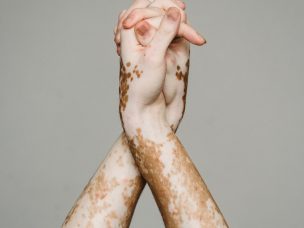December 14, 2022
Antiseptic Tulle Gras Dressing With Skin Graft in Vitiligo
Antiseptic tulle gras dressing is an effective approach to applying an ultrathin skin graft template on depigmented areas in recalcitrant vitiligo. This method helps prevent graft displacement and deformity (curling and wrinkling) of its edges. Recalcitrant vitiligo requires rapid repigmentation. Ultrathin split-thickness skin grafting constitutes an effective surgical treatment of recalcitrant vitiligo. In vitiligo, the...
Topical Photochemotherapy and Idiopathic Guttate Hypomelanosis-Like Macules in Vitiligo
The emergence of macular IGH-like lesions is a reversible and rare adverse effect following photochemotherapy in vitiligo patients. Phototherapy is a safe and effective treatment for stable vitiligo in the pediatric population. A rare side effect of phototherapy is the formation of small and well-defined depigmented macules, specifically in skin regions with exposure to ultraviolet...
Immunometabolism in Vitiligo Pathogenesis
Vitiligo is characterized by underlying immunometabolism mechanisms. These serve as the basis for understanding the pathogenic mechanisms and the development of novel therapeutic approaches. Vitiligo is an autoimmune depigmenting skin disorder associated with selective melanocyte loss. The pathogenesis of vitiligo comprises biological, environmental, autoimmune, and genetic factors; however, complete molecular mechanisms underlying the development of...
Topical Formulation With MIA-Inhibitory Peptides in Recalcitrant Vitiligo
Melanoma Inhibitory Activity (MIA) is an effective therapeutic target for recalcitrant non-segmental vitiligo, in combination with oral antioxidant medications and UVA or sun exposure. Vitiligo is characterized by acquired autoimmune depigmentation of the skin. Studies based on an animal model have suggested the involvement of melanoma inhibitory activity (MIA) protein in vitiligo pathogenesis. MIA protein...
Topical Niclosamide for Staphylococcus aureus Colonization in Atopic Dermatitis
For decolonizing atopic dermatitis lesions infected with Staphylococcus aureus, 2% ATx201 ointment is a safe and effective treatment. Staphylococcus aureus is frequently associated with the colonization of lesions in atopic dermatitis (AD) patients. This may contribute to the severity and progression of AD in these individuals. This highlights the need for treatments that reduce the...
Fig Leaf Tea in Mild Atopic Dermatitis
Fig leaf tea is safe and effective for reducing EASI values in patients with mild AD and can be taken continuously for the management of AD symptoms. Atopic dermatitis (AD) is a recurrent pruritic skin disease that does not have a definitive cure. Previous studies on animals and cultured cells have demonstrated the role of...
Efficacy and Safety of Abrocitinib in Phase 3 JADE EXTEND Trial
Abrocitinib is a JAK-1 selective inhibitor that is safe and effective for the treatment of moderate-to-severe atopic dermatitis in prior dupilumab responders as well as nonresponders in the current JADE EXTEND trial. There are limited treatment options for moderate-to-severe atopic dermatitis (AD) that is not responsive to topical formulations. Dupilumab, an anti-interleukin 4 receptor alpha...






